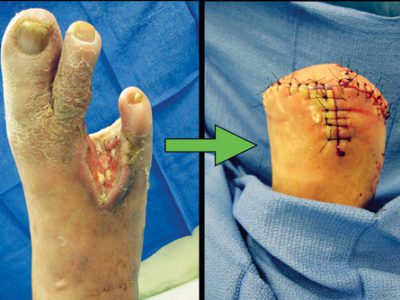Functional Foot Salvage Surgeries
Diabetic foot syndrome is one of the most common long-term complications of chronic hyperglycemia and a major source of morbidity and mortality. More than 60% of nontraumatic amputations are attributed to diabetes, 80% of which are preceded by a foot ulcer.
Peripheral neuropathy, peripheral vascular disease, ipsilateral foot ulcer, previous amputation, male gender, and insulin therapy have been reported as risk factors for lower extremity amputation (LEA). Limb preservation in patients with diabetes mellitus is a challenging process that aims to prevent major limb loss in a population often plagued by multiple comorbidities. Employing a multidisciplinary approach has proved advantageous in improving limb salvage rates in the diabetic population.
Prevention of diabetic foot disease through glycemic control, periodic foot examinations, callus debridement, shoe-gear recommendations, deformity prevention and accommodation, and patient education is the first line of defense against amputation. However, surgical intervention frequently becomes necessary to eradicate infection, remove necrotic tissue, close chronic wounds, eliminate structural causes of tissue breakdown, and reconstruct deformities.
The foot and ankle surgeon is one of the foremost players in the limb salvage effort, assuming the difficult tasks of preserving extremities through various surgical techniques and preventing and managing complications postoperatively. Providing each patient with a functional, biomechanically sound, and shoe-able foot that is free of infection, while minimizing the risk of tissue breakdown and recurrent infection, is integral to a successfully salvaged limb. Efficiently achieving these objectives decreases the threat of a major LEA, prolongs survival, promotes independence, and evades quality of life (QOL) deterioration.

